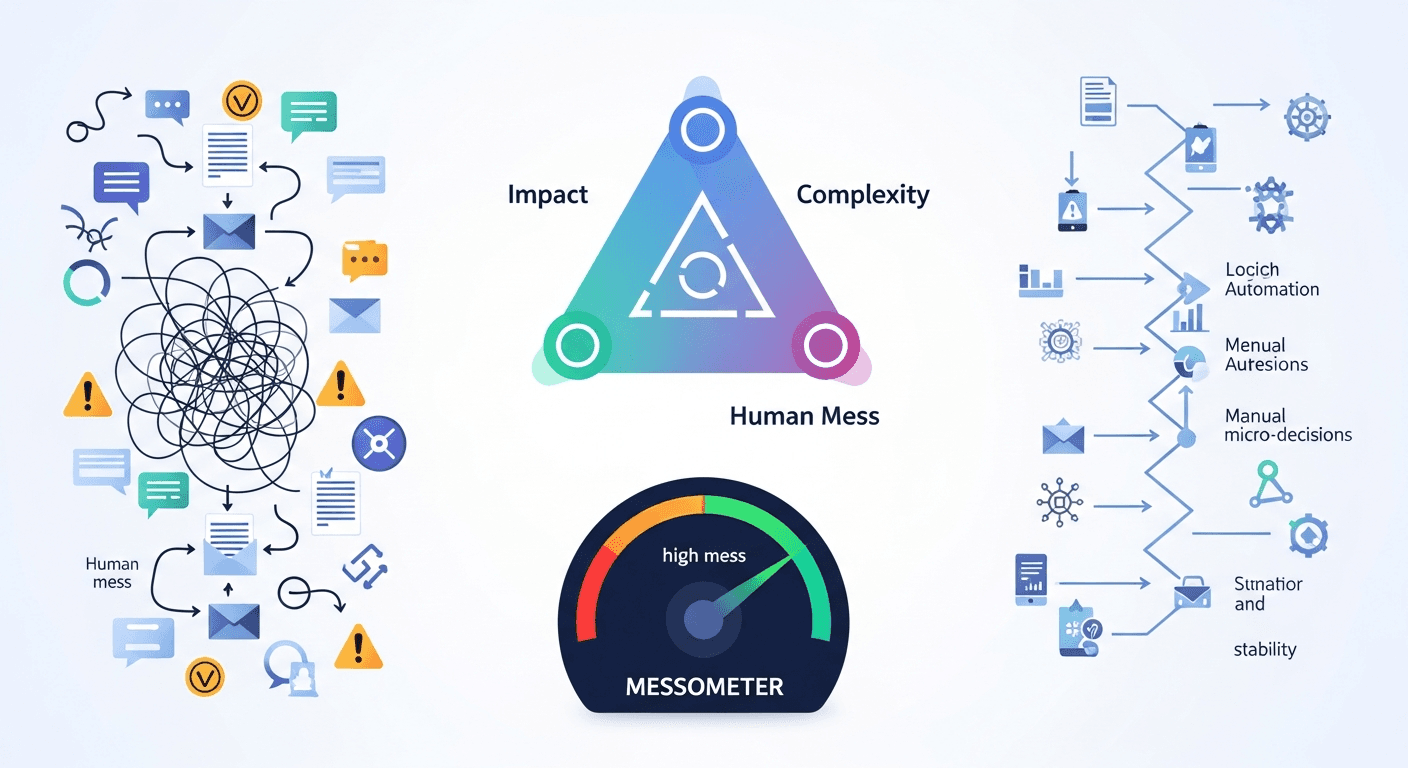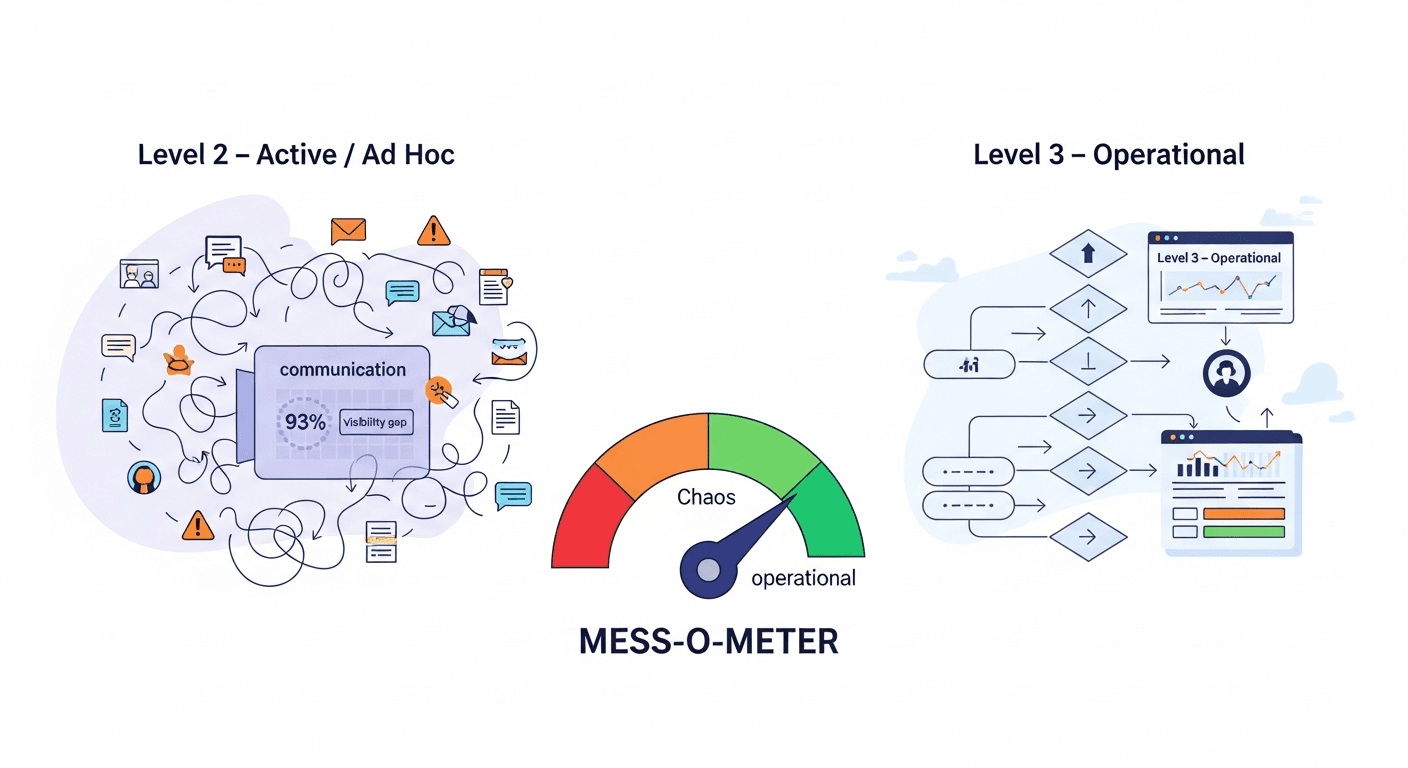Thursday, 13 Nov 2025
|How Exactly Mess-O-Meter Work? Exact Steps and Examples

How Exactly Mess-O-Meter Work? Exact Steps and Examples
The Mess-O-Meter is a strategic diagnostic tool designed to reveal and quantify all the hidden chaos inside a business—especially the parts that depend heavily on human communication, manual steps, and undocumented decision-making. Understanding the Mess-o-meter working process is essential for any company that wants to eliminate inefficiencies and decide exactly where AI should be implemented for the fastest impact.
In this guide, we’ll break down the exact steps, show examples, and explain how the Mess-O-Meter becomes the foundation for AI-driven transformation.
What Is the Mess-O-Meter?
The Mess-O-Meter is a structured method for uncovering:
- Hidden workflow chaos
- Human-dependent processes
- Manual micro-decisions
- Tribal knowledge
- Communication overload
It acts as a measurement tool that feeds into a Framework for Structured Decisioning and Prioritization, which ultimately tells leaders:
👉 “Here is exactly where AI should go first.”
Why Organizations Need a Mess Measurement System
Most businesses think their biggest problems are technical.
But research shows that 93% of companies lack visibility into the communication-driven parts of their workflow.
That means the real bottlenecks are:
- Unwritten processes
- Endless Slack/Teams threads
- Manual checks
- Repeated clarifications
- Siloed teams
- Human-driven exceptions
These invisible problems are what the Mess-O-Meter measures.
The Communication Black Box Problem
Every company has a “black box” where decisions happen informally:
- Over email
- In chat threads
- Through calls
- Between two specific employees
- Inside someone’s head
The Mess-O-Meter shines a light inside this black box and turns the chaos into structured, measurable data.
The Mess-O-Meter Working Process: Step-by-Step Overview
Below is the full Mess-o-meter working process, simplified and mapped with examples.
Step 1: Identify All the Flows
This means mapping every step of the workflow—from beginning to end.
Example:
In a logistics company, the flow might be:
Order received
Data validation
Carrier assignment
Label creation
Pickup scheduling
Delivery tracking
The Mess-O-Meter identifies all flows before analyzing them.
Step 2: Find Issues in Each Flow
For each step, the Mess-O-Meter uncovers:
- Delays
- Manual interventions
- Chaos in communication
- Exceptions
- Rework
- Bottlenecks
Example:
If “carrier assignment” requires 12 emails and 3 checks, the tool flags it as a high-mess area.
Step 3: Categorize Issues Into 3 Types of Mess
All issues fall into one of three buckets:
1. Human Mess
These are workflow inefficiencies caused by human dependency, such as:
- Overreliance on email, chat, and phone
- Tribal knowledge
- Endless micro-decisions
- Manual validations
- Reactive firefighting
Example:
A warehouse team relies on a single person to approve exceptions.
2. Product Mess
These are UX or process issues inside tools or software.
Examples:
- Confusing UI
- Too many clicks
- Missing features
- Complex steps
Example:
The system requires users to manually re-enter tracking numbers.
3. Technical Mess
These are infrastructure or data issues.
Examples:
- APIs failing
- Data not syncing
- Slow systems
- Outdated integrations
Example:
Shipment data arrives 4 hours late due to batch processing.
Step 4: Generate the Mess Dashboard & Report
Once the issues are classified, the Mess-O-Meter produces:
- A numerical “Human Mess” score
- Visual dashboards
- Flow-by-flow analysis
- Mess heat maps
- Priority zones
This gives leaders something they never had before:
👉 Visibility into the hidden mess.
Step 5: Decide Where to Implement AI
This is the most important part of the Mess-o-meter working process.
Using the dashboard, organizations determine exactly where AI will have the highest impact.
AI is deployed where:
- Human mess is high
- Impact is high
- Complexity is low or medium
This stops random AI experimentation and focuses the business on high-value automation opportunities.
Phase 1: Diagnosis & Measurement (Deep Dive)
Identifying the Communication Black Box
Most of the mess lies in the parts of the process that tools cannot track.
The Mess-O-Meter uncovers:
- Hidden waits
- Shadow workflows
- People-dependent decisions
- Manual approvals
This diagnosis allows leaders to finally see what has always been invisible.
Quantifying Human Mess
The tool scores:
- Number of emails
- Frequency of chats
- Manual decision counts
- Exceptions
- Rework loops
- Escalations
This produces the Human Mess Score.
Phase 2: Structured Decision-Making & Prioritization
Once the mess is measured, the organization uses the Triangulation Framework:
The 3 Inputs:
Human Mess (from the Mess-O-Meter)
Impact (value created when fixed)
Complexity (effort required to automate)
How Prioritization Works
Scenario
Action
High Mess + High Impact + Low Complexity
Automate Immediately
High Mess + Medium Impact + Medium Complexity
Short-term AI Project
Low Mess + Low Impact + High Complexity
Ignore for Now
This is where the Mess-O-Meter becomes truly strategic.
Phase 3: AI Action & Transformation
Applying Agentic AI
AI agents and orchestration systems automate:
- Manual micro-decisions
- Repetitive checks
- Communication-heavy tasks
- Exception management
- Dispatching and routing
From Human Mess to Human Potential
The ultimate purpose is:
👉 “From human mess to greater human potential.”
By removing the messy work, humans can focus on:
- Creativity
- Strategy
- Innovation
- Customer relationships
Real Examples of Mess-O-Meter Working
Below are simple examples showing how the tool works in real-world operations.
1. Logistics Example
Mess identified:
Too many emails between warehouse and carrier.
AI solution:
An AI agent automatically chooses the best carrier and updates all systems.
Outcome:
- Less manual work
- Faster dispatch
- Lower cost per shipment
2. Customer Support Example
Mess identified:
Agents manually categorize tickets.
AI solution:
AI agent auto-classifies and routes tickets.
Outcome:
- Faster response
- Less human dependency
- Higher accuracy
3. Warehouse Example
Mess identified:
Inventory exceptions require supervisor approval.
AI solution:
AI agent handles common exceptions automatically.
Outcome:
- Higher throughput
- Smoother operations
- Fewer delays
See your Mess-O-Meter in minutes.
FAQs
1. What does the Mess-O-Meter measure?
It measures workflow chaos, communication overload, and human-dependent steps.
2. Does it replace process mapping?
No—it enhances it by revealing the hidden mess not visible in traditional process maps.
3. What happens after the score is generated?
It is used in a prioritization framework to determine where AI should be deployed.
4. Does the Mess-O-Meter include technical issues?
Yes—issues are categorized into human mess, product mess, and technical mess.
5. Is it only for logistics?
No—it applies to customer support, finance, HR, operations, and more.
6. Why is it important for AI planning?
It tells leaders exactly where AI will have maximum impact.
Conclusion
The Mess-o-meter working method gives organizations a powerful way to expose hidden chaos, prioritize improvements, and strategically implement AI where it matters most. By following the five steps—mapping flows, finding issues, categorizing them, generating dashboards, and choosing AI opportunities—companies can confidently progress toward higher efficiency, lower costs, and stronger performance.
All blog posts
View All →
Tuesday, 18 Nov 2025
AI Prioritization with the Mess-O-Meter Framework
Triangulate impact, complexity, and human mess with the messometer to prioritize AI projects scientifically and reduce failure risk.

Monday, 17 Nov 2025
Escape Level 2 AI Maturity with the Mess-O-Meter
Use the messometer to measure manual micro-decisions and chaotic workflows so you can move from ad hoc AI experiments to operational, scalable AI.

Saturday, 15 Nov 2025
The 93% Visibility Gap: Why the Mess-O-Meter Is Your Powerful First Step in the AI Maturity Journey
Discover how the messometer exposes the hidden “communication black box” in your workflows. Learn why diagnosing this 93% visibility gap is essential before any AI implementation to avoid failure.